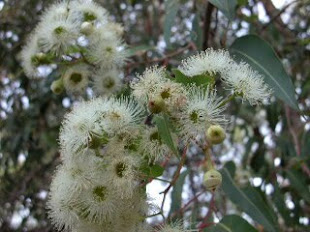One of the big threats to local bushland is land clearing. Often, bushland is cleared in one morning's work in a bulldozer. It's very sad to see the carnage afterwards - broken trees, shrubs that have been ripped out of the ground, plants that could have been transplanted but were instead broken in half, dead lizards, and perhaps the most heart-rending; birds flying around trying to land in invisible trees where their nests had been. There must be a better way to create a new subdivision than this.
Some of our local animals are very slow moving, especially the reptiles in cool weather. They're just not fast enough to get away from a bulldozer. This bobtail was run over by a bulldozer.
At other times, bushland dies a death of a thousand cuts - what starts as healthy trees and understorey is gradually killed off by the actions of grazing animals, off-road enthusiasts, arsonists, rubbish dumpers, weeds and feral animals. At the end of this, the patch of bushland may be so severely degraded that it no longer looks attractive, and owners or neighbours are keen to see it bulldozed.
One of the aims of the Ellenbrook Bushland Group is to educate people on how to look after bushland. Firstly, it's about showing people the value of bushland. Bushland helps to improve our local air, water and soil quality, and a walk amongst healthy trees and birds is good for one's health and wellbeing. It's perhaps even more enjoyable if you know what you are looking at when you go for a walk - if you can put a name to the flowers and trees, and understand how the animals fit in. How many people have seen this little animal, and know what it is?
I'm still surprised by people who look at wildflowers and think they are just weeds; it just shows how little some people know about where they live. For example, I've heard banksia woodland (shown below) described as "just scrub" or "cr@ppy bushland". (Have some respect!!)
Secondly, it's knowing that bushland doesn't need fertilizers, sprinklers, mulch, or other "exotic" treatments to stay healthy (and these things are actually detrimental to the health of our bushland.) It's appreciating the ancient trees, cycads and other plants for what they are. It's recognising the amazing adaptations in our local bushland; the intricate webs that strengthen the survival rates of the lifeforms, and produce a stunning array of patterns, shapes, colours, smells and movement...this is what biodiversity is about, and we are part of it.
We need to ensure that the small areas of bushland still remaining are retained. And we can all help by picking up the occasional scrap of rubbish, pulling a weed out, and keeping our vehicles and pets out of nature reserves.
Our Bushland Diary
Saturday, July 31, 2010
Subscribe to:
Posts (Atom)





